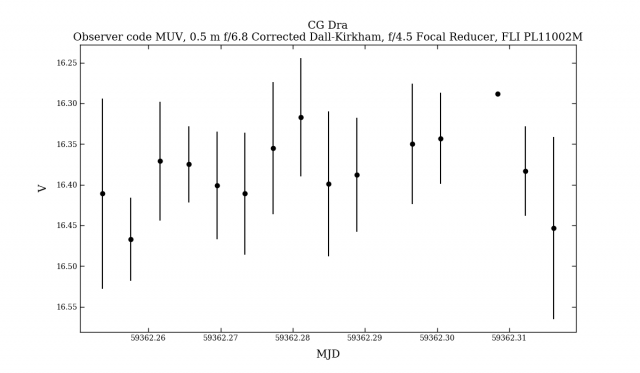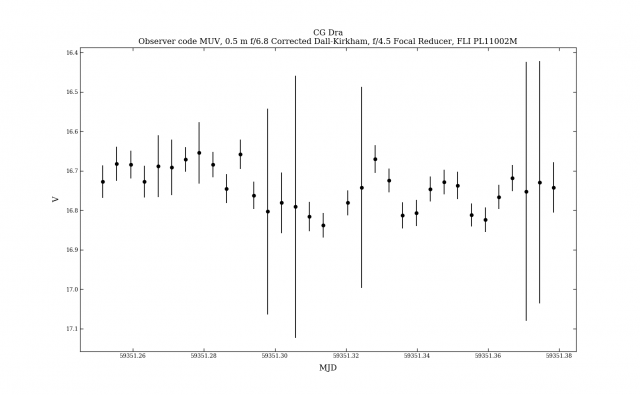Forum Replies Created
-
AuthorPosts
-
 Maxim UsatovParticipant
Maxim UsatovParticipantHad a run on CG Dra tonight.
Attachments:
 Maxim UsatovParticipant
Maxim UsatovParticipantThank you, Andy!
 Maxim UsatovParticipant
Maxim UsatovParticipantI wonder if there are any campaigns to monitor this object. Any guidelines? Anything we can contribute with?
 Maxim UsatovParticipant
Maxim UsatovParticipantHi Gary,
I do not see it at 13.6. Here is a 120 s V-band exposure of the field. It is supposed to be right next to the marked 15.86 star.
Attachments:
 Maxim UsatovParticipant
Maxim UsatovParticipantRobin, I wonder if this is due to the Swings effect and the varying g-factor producing different fluorescence intensities. Looks like the ratios in your data are within the range for CN. Please see attached two relevant pages from the book “Comets” by J. A. Fernandez.
 Maxim UsatovParticipant
Maxim UsatovParticipantAmazing!
14 December 2021 at 9:54 am in reply to: Introducing MetroPSF – a program for ensemble photometry #585014 Maxim UsatovParticipant
Maxim UsatovParticipantHi Paul,
Thank you very much for your feedback. This type of error occurs if the input to the linear regression function has a blank value, which is unexpected. This could be, for example, if the star catalog returns a blank magnitude for some reason, or the ensemble has zero stars (too limited). Is there an option for you to try a different star catalog? How many stars are in your ensemble? Please note no screenshot was attached.
Max
 Maxim UsatovParticipant
Maxim UsatovParticipantSorry. Here is a working link: http://pure.southwales.ac.uk/files/1764788/stw3334.pdf
 Maxim UsatovParticipant
Maxim UsatovParticipantThank you, Nick. Yes, we use ACP and a web front-end so users could submit plans easily. MetroPSF can now detect all minor planets and comets (all SkyBoT objects) – this version is to be released, but the plan is to build it into the front-end as well. The sensor is IMX455 – back-illuminated CMOS, that is correct.
 Maxim UsatovParticipant
Maxim UsatovParticipantThis is incredible. Added to my wishlist. Thank you very much!
 Maxim UsatovParticipant
Maxim UsatovParticipantMy team is currently setting up a 17″ CDK in Spain with IMX455-based CMOS. It will have a user-friendly interface for reservation, plan generation, etc. The telescope is already operational, but we need now to finalize all the scripting, web front-end, logic, and a few other things. Here are more details about this endeavor:
I would like to negotiate donating a specific portion of time on this telescope to BAA. I would appreciate if someone could provide me with any pointers on how to start this. It has UBVRI set of Johnson/Bessel filters, in addition to LRGB, H-alpha, OIII and SII filters, so fully ready for photometry. In fact, we are thinking about connecting my MetroPSF program to the front-end, so if you need quick photometry you can just quickly specify the target and get fully reduced photometry – automated, even in real-time, if needed. (But that’s in the future…)
This is the first telescope our team is setting up and we would be very interested to be of use for BAA, especially if the data is used for scientific research and publications.
Maxim
 Maxim UsatovParticipant
Maxim UsatovParticipantFound this paper as well on dust shells that might be of interest.
 Maxim UsatovParticipant
Maxim UsatovParticipantCG Dra, 2021-05-29 09:17:01.000 UTC, V = 16.71 ± 0.091
Difficult to get any good accuracy due to the Moon now.
28 May 2021 at 10:17 pm in reply to: Introducing MetroPSF – a program for ensemble photometry #584273 Maxim UsatovParticipant
Maxim UsatovParticipantNick, I took exposure start from the “JD” field in the FITS, never looked at DATE-OBS. MetroPSF now looks at DATE-OBS as well. I have uploaded the fixed 0.15 here:
http://trafyx.com/wp-content/uploads/2021/05/metropsf-0.15.zip
Thanks for pointing this out.
Max
 Maxim UsatovParticipant
Maxim UsatovParticipantA few more observations – moonlit sky.
 27 May 2021 at 9:33 pm in reply to: Introducing MetroPSF – a program for ensemble photometry #584269
27 May 2021 at 9:33 pm in reply to: Introducing MetroPSF – a program for ensemble photometry #584269 Maxim UsatovParticipant
Maxim UsatovParticipantThank you, Eric. It can process the whole folder of input images and report in batch, but reports are generated only for objects from the AAVSO VSX database. I’ve never tried it on comets. If you could send me a series of FITS with a comet – three is enough – I could try to see if I can get it reporting.
27 May 2021 at 9:33 am in reply to: Introducing MetroPSF – a program for ensemble photometry #584266 Maxim UsatovParticipant
Maxim UsatovParticipantThanks, Nick. With those automatic reports one has to be careful, as you might need an ensemble covering a wide range of magnitudes which will raise uncertainties. Perhaps, we need to add an option to fine-tune the range of magnitudes in the ensemble per each target automatically during automatic reporting?
On the timestamps: I’ve just tested a few FITS on my Windows 10 machine and don’t see any issues. Could you please send me the FITS file for testing? Very odd.
Max
26 May 2021 at 9:50 pm in reply to: Introducing MetroPSF – a program for ensemble photometry #584264 Maxim UsatovParticipant
Maxim UsatovParticipantWhoops. Forgot to specify encoding for the log file which obviously produces an error on Windows. Please try this fixed version:
http://trafyx.com/wp-content/uploads/2021/05/metropsf-0.15.zip
24 May 2021 at 11:05 pm in reply to: Introducing MetroPSF – a program for ensemble photometry #584262 Maxim UsatovParticipant
Maxim UsatovParticipantHappy to announce the latest version of MetroPSF, 0.15. Lots of new stuff:
• Aperture photometry.
This is similar to common aperture photometry algorithms found in other software except that a 2D model of the background is subtracted from the image, so sky annuli are not used.• AAVSO report generation.
MetroPSF can now generate AAVSO-compatible report files.• Automatic reporting on all VSX sources in the image.
MetroPSF can generate reports on all VSX sources found in the image. It cycles through each VSX variable and builds a report file. Although I would not recommend to do automatic reports and submit them blindly (unless you know what exactly you are doing) this is helpful when you need to process multiple FITS files to create a report on a single object or multiple objects with, say, similar magnitudes.• Batch processing of all FITS files in a folder.
Now it is possible to do photometric series, as MetroPSF can process multiple FITS files in a folder at once…• Light curve generation from BAA reports.
…and display a light curve from all the report files generated.• Added ability to remove outliers from the fit – by ensemble limit and maximum separation.
Much more precise photometry, as you can set it up to automatically exclude comparison stars farther than R arcseconds from the target, or that are not fitting well into the comparison ensemble, e.g. limit ensemble to N stars.Convenience changes:
• Reporting number of ensemble stars on the linear regression fit plot.
• Object name in the left panel is now automatically set from VSX catalog for matching sources.
• Display next VSX source.
Can easily cycle through all known variables in your image.• Mouse click now reports time in ISO UTC format along with photometry result.
To copy-paste in forums and discussions.Other changes:
• Increased Astrometry.Net default solve timeout from 120 to 360 s.
• Linear regression fit error is now based on standard deviation.
• MetroPSF now writes a log to metropsf.log.
• Astrometry.net URL and API key setting in the interface.
• PSF fitting algorithm setting.
• FITS crop option.Latest manual: http://trafyx.com/wp-content/uploads/2021/05/metropsf.pdf
MetroPSF program and manual: http://trafyx.com/wp-content/uploads/2021/05/metropsf-0.15.zipMax
 Maxim UsatovParticipant
Maxim UsatovParticipantGot a good session on May 17th. First observation 06:02, last 09:04 UTC. I wonder, is this a ~ 0.2 mag flickering or irregular modulations or this is actually an eclipse? In case of the latter then why the exit follows by an irregular tail – clumpy accretion disk?

-
AuthorPosts


